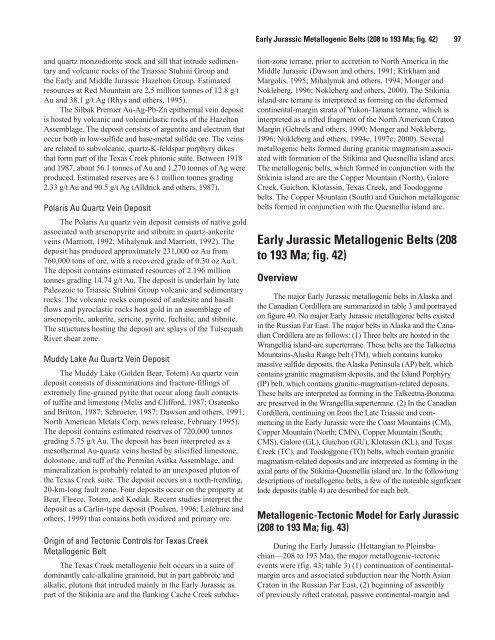USGS Professional Paper 1697 - Alaska Resources Library
USGS Professional Paper 1697 - Alaska Resources Library
USGS Professional Paper 1697 - Alaska Resources Library
You also want an ePaper? Increase the reach of your titles
YUMPU automatically turns print PDFs into web optimized ePapers that Google loves.
and quartz monzodiorite stock and sill that intrude sedimentary<br />
and volcanic rocks of the Triassic Stuhini Group and<br />
the Early and Middle Jurassic Hazelton Group. Estimated<br />
resources at Red Mountain are 2.5 million tonnes of 12.8 g/t<br />
Au and 38.1 g/t Ag (Rhys and others, 1995).<br />
The Silbak Premier Au-Ag-Pb-Zn epithermal vein deposit<br />
is hosted by volcanic and volcaniclastic rocks of the Hazelton<br />
Assemblage. The deposit consists of argentite and electrum that<br />
occur both in low-sulfide and base-metal sulfide ore. The veins<br />
are related to subvolcanic, quartz-K-feldspar porphyry dikes<br />
that form part of the Texas Creek plutonic suite. Between 1918<br />
and 1987, about 56.1 tonnes of Au and 1,270 tonnes of Ag were<br />
produced. Estimated reserves are 6.1 million tonnes grading<br />
2.33 g/t Au and 90.5 g/t Ag (Alldrick and others, 1987).<br />
Polaris Au Quartz Vein Deposit<br />
The Polaris Au quartz vein deposit consists of native gold<br />
associated with arsenopyrite and stibnite in quartz-ankerite<br />
veins (Marriott, 1992; Mihalynuk and Marriott, 1992). The<br />
deposit has produced approximately 231,000 oz Au from<br />
760,000 tons of ore, with a recovered grade of 0.30 oz Au/t.<br />
The deposit contains estimated resources of 2.196 million<br />
tonnes grading 14.74 g/t Au. The deposit is underlain by late<br />
Paleozoic to Triassic Stuhini Group volcanic and sedimentary<br />
rocks. The volcanic rocks composed of andesite and basalt<br />
flows and pyroclastic rocks host gold in an assemblage of<br />
arsenopyrite, ankerite, sericite, pyrite, fuchsite, and stibnite.<br />
The structures hosting the deposit are splays of the Tulsequah<br />
River shear zone.<br />
Muddy Lake Au Quartz Vein Deposit<br />
The Muddy Lake (Golden Bear, Totem) Au quartz vein<br />
deposit consists of disseminations and fracture-fillings of<br />
extremely fine-grained pyrite that occur along fault contacts<br />
of tuffite and limestone (Melis and Clifford, 1987; Osatenko<br />
and Britton, 1987; Schroeter, 1987; Dawson and others, 1991;<br />
North American Metals Corp, news release, February 1995).<br />
The deposit contains estimated reserves of 720,000 tonnes<br />
grading 5.75 g/t Au. The deposit has been interpreted as a<br />
mesothermal Au-quartz veins hosted by silicified limestone,<br />
dolostone, and tuff of the Permian Asitka Assemblage, and<br />
mineralization is probably related to an unexposed pluton of<br />
the Texas Creek suite. The deposit occurs in a north-trending,<br />
20-km-long fault zone. Four deposits occur on the property at<br />
Bear, Fleece, Totem, and Kodiak. Recent studies interpret the<br />
deposit as a Carlin-type deposit (Poulsen, 1996; Lefebure and<br />
others, 1999) that contains both oxidized and primary ore.<br />
Origin of and Tectonic Controls for Texas Creek<br />
Metallogenic Belt<br />
The Texas Creek metallogenic belt occurs in a suite of<br />
dominantly calc-alkaline granitoid, but in part gabbroic and<br />
alkalic, plutons that intruded mainly in the Early Jurassic as<br />
part of the Stikinia arc and the flanking Cache Creek subduc-<br />
Early Jurassic Metallogenic Belts (208 to 193 Ma; fig. 42) 97<br />
tion-zone terrane, prior to accretion to North America in the<br />
Middle Jurassic (Dawson and others, 1991; Kirkham and<br />
Margolis, 1995; Mihalynuk and others, 1994; Monger and<br />
Nokleberg, 1996; Nokleberg and others, 2000). The Stikinia<br />
island-arc terrane is interpreted as forming on the deformed<br />
continental-margin strata of Yukon-Tanana terrane, which is<br />
interpreted as a rifted fragment of the North American Craton<br />
Margin (Gehrels and others, 1990; Monger and Nokleberg,<br />
1996; Nokleberg and others, 1994c, 1997c; 2000). Several<br />
metallogenic belts formed during granitic magmatism associated<br />
with formation of the Stikinia and Quesnellia island arcs.<br />
The metallogenic belts, which formed in conjunction with the<br />
Stikinia island arc are the Copper Mountain (North), Galore<br />
Creek, Guichon, Klotassin, Texas Creek, and Toodoggone<br />
belts. The Copper Mountain (South) and Guichon metallogenic<br />
belts formed in conjunction with the Quesnellia island arc.<br />
Early Jurassic Metallogenic Belts (208<br />
to 193 Ma; fig. 42)<br />
Overview<br />
The major Early Jurassic metallogenic belts in <strong>Alaska</strong> and<br />
the Canadian Cordillera are summarized in table 3 and portrayed<br />
on figure 40. No major Early Jurassic metallogenic belts existed<br />
in the Russian Far East. The major belts in <strong>Alaska</strong> and the Canadian<br />
Cordillera are as follows: (1) Three belts are hosted in the<br />
Wrangellia island-arc superterrane. These belts are the Talkeetna<br />
Mountains-<strong>Alaska</strong> Range belt (TM), which contains kuroko<br />
massive sulfide deposits, the <strong>Alaska</strong> Peninsula (AP) belt, which<br />
contains granitic magmatism deposits, and the Island Porphyry<br />
(IP) belt, which contains granitic-magmatism-related deposits.<br />
These belts are interpreted as forming in the Talkeetna-Bonzana<br />
arc preserved in the Wrangellia superterrane. (2) In the Canadian<br />
Cordillera, continuing on from the Late Triassic and commencing<br />
in the Early Jurassic were the Coast Mountains (CM),<br />
Copper Mountain (North; CMN), Copper Mountain (South;<br />
CMS), Galore (GL), Guichon (GU), Klotassin (KL), and Texas<br />
Creek (TC), and Toodoggone (TO) belts, which contain granitic<br />
magmatism-related deposits and are interpreted as forming in the<br />
axial parts of the Stikinia-Quesnellia island arc. In the followiung<br />
descriptions of metallogenic belts, a few of the noteable signficant<br />
lode deposits (table 4) are described for each belt.<br />
Metallogenic-Tectonic Model for Early Jurassic<br />
(208 to 193 Ma; fig. 43)<br />
During the Early Jurassic (Hettangian to Pleinsbachian—208<br />
to 193 Ma), the major metallogenic-tectonic<br />
events were (fig. 43; table 3) (1) continuation of continentalmargin<br />
arcs and associated subduction near the North Asian<br />
Craton in the Russian Far East, (2) beginning of assembly<br />
of previously rifted cratonal, passive continental-margin and
















